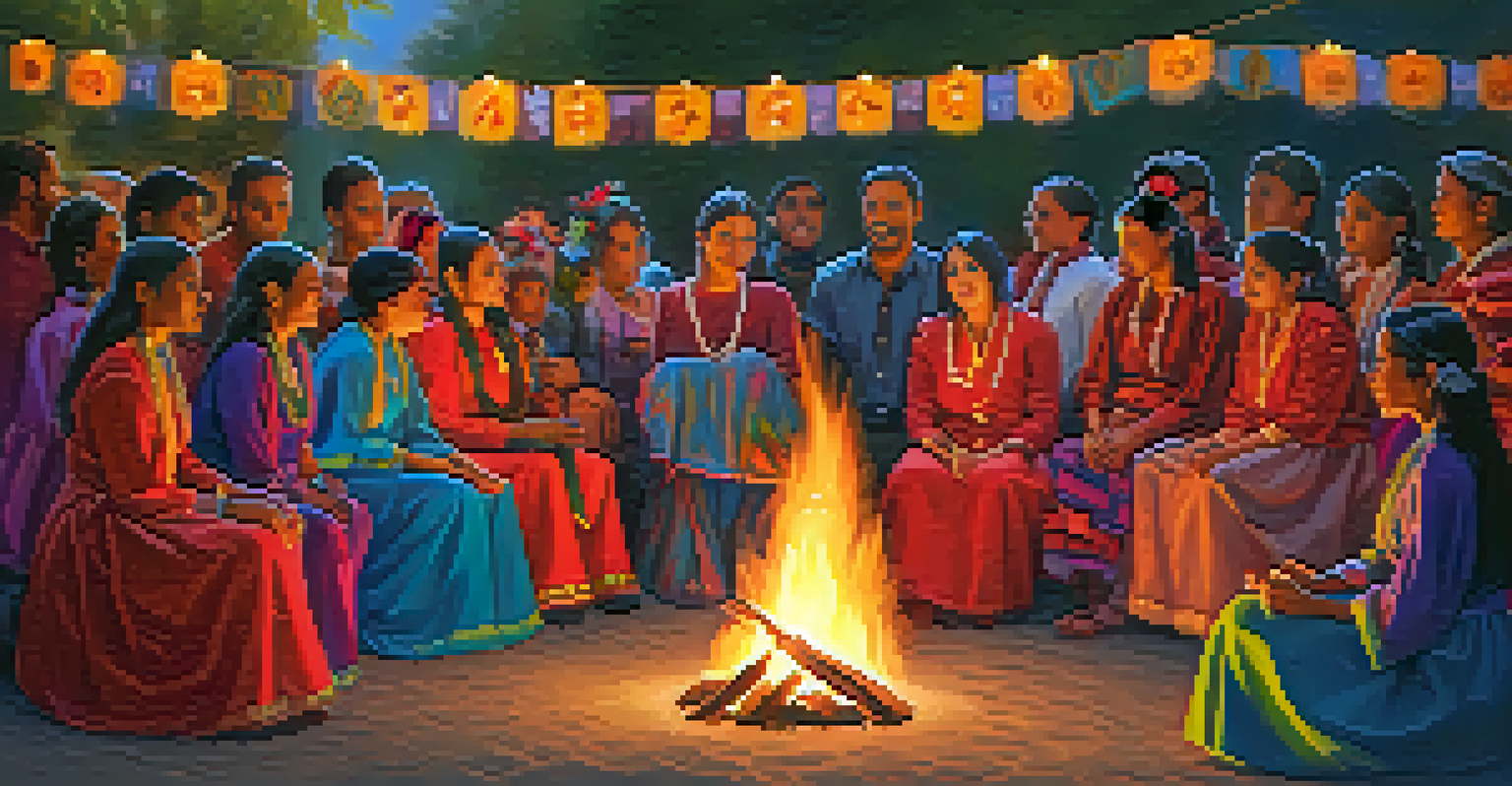The Legend of La Llorona: California’s Weeping Woman Tale

The Origins of La Llorona: A Tragic Folktale
La Llorona, or 'The Weeping Woman,' is a haunting tale with roots in Mexican folklore. Legend has it that she was a beautiful woman named Maria who tragically lost her children. Overcome with grief, she weeps for them, wandering near rivers and lakes, calling their names in despair. This story serves as a cautionary tale, warning children to stay away from water at night.
La Llorona is a powerful symbol of the struggles of motherhood and the pain of separation.
The origins of La Llorona are often traced back to the colonial period, blending Indigenous traditions with Spanish influences. Various versions exist, with some depicting her as a scorned lover who drowned her children in a fit of rage. Regardless of the version, the core theme remains consistent: a mother's undying love twisted into eternal sorrow. This tragic narrative resonates deeply within the cultural consciousness, often sparking discussions about love, loss, and regret.
In California, La Llorona has become a significant part of local lore, especially among Latino communities. The tale is often told around campfires, passed down through generations, and serves to connect people with their cultural heritage. As new generations hear the story, they add their interpretations, ensuring that La Llorona's legacy continues to evolve while maintaining its haunting essence.
La Llorona in California: A Cultural Intersection
California's diverse population has embraced La Llorona, adapting the legend to fit various cultural contexts. In many Latino communities, she symbolizes the struggles of motherhood and the pain of separation. This connection can be seen at cultural events, where tales of La Llorona are shared, highlighting the shared experiences of loss and grief among families.

The state’s rich tapestry of cultures has led to unique interpretations of La Llorona’s story. For example, some versions emphasize her role as a protector of children, warning them of danger, while others portray her as a tragic figure seeking redemption. This flexibility in storytelling allows La Llorona to remain relevant, resonating with both young and old, and fostering a sense of community among those who share her tale.
La Llorona: A Tale of Love and Loss
The story of La Llorona reflects deep emotional themes of motherhood, grief, and societal expectations.
Moreover, La Llorona has made her way into popular culture, appearing in films, literature, and even music. These adaptations often explore themes of heartbreak, sacrifice, and the supernatural, keeping the legend alive in modern contexts. As audiences engage with these retellings, they gain new perspectives on the classic tale, showcasing the enduring power of folklore.
The Emotional Impact of La Llorona's Tale
The story of La Llorona elicits strong emotional reactions, often stirring feelings of empathy and sorrow. Many listeners can relate to the themes of loss and regret, making the tale resonate on a personal level. This emotional connection allows the legend to transcend mere storytelling, becoming a vessel for shared experiences of grief and longing.
The story of La Llorona resonates on a personal level, serving as a vessel for shared experiences of grief and longing.
As children hear the story, they may feel a mix of fear and fascination, which serves to strengthen familial bonds. Parents often use the tale as a way to teach lessons about caution, especially regarding water safety. In this way, La Llorona becomes a multifaceted figure—both a source of fear and a reminder of parental love and responsibility.
The emotional weight of La Llorona's story can also lead to deeper conversations about mental health and the societal pressures faced by mothers. Discussing her tale can provide an opportunity for individuals to express their feelings about loss and grief, fostering understanding and support within communities. In this sense, La Llorona serves not only as a folklore icon but also as a catalyst for healing.
La Llorona: A Symbol of Motherhood and Loss
At its core, La Llorona embodies the complexities of motherhood, illustrating both love and loss. Her story reflects the struggles many mothers face, particularly those navigating difficult circumstances. This duality allows listeners to explore their own experiences with motherhood, whether it be joy, sorrow, or both.
The legend also highlights societal expectations placed on women, especially regarding their roles as caregivers. La Llorona’s tragic fate serves as a cautionary tale about the consequences of failing to meet these expectations, resonating with many who feel the weight of such pressures. In this way, her story becomes a lens through which to examine gender roles and societal norms.
Cultural Adaptation in California
In California, La Llorona's legend has evolved within Latino communities, symbolizing shared experiences of loss and resilience.
As a symbol of loss, La Llorona reminds us of the fragility of life and the profound impact of grief. Her weeping echoes the pain of those who have experienced loss, creating a shared understanding among listeners. This ability to evoke such strong emotions makes La Llorona an enduring figure in folklore, one that continues to resonate across generations.
Modern Interpretations of La Llorona
In recent years, La Llorona has inspired a resurgence of interest in folklore, particularly among younger generations. Films and literature have reimagined her story, exploring new themes and perspectives. These modern interpretations often delve into her backstory, presenting her not just as a ghostly figure, but as a complex character shaped by her experiences.
For instance, some adaptations portray La Llorona as a victim of circumstance, emphasizing the societal factors that led to her tragic fate. This shift in narrative invites audiences to empathize with her struggles, fostering a deeper understanding of her character. By reframing her story, these interpretations challenge traditional views and promote discussions about mental health and societal expectations.
Social media has also played a significant role in revitalizing interest in La Llorona. Memes and online discussions allow people to share their interpretations and experiences related to the legend. This digital engagement not only keeps the tale alive but also encourages a sense of community among those who connect through shared stories.
The Legacy of La Llorona in Contemporary Culture
La Llorona’s legacy extends beyond folklore; she has become a symbol of resilience and cultural identity. In contemporary culture, her story resonates with those navigating the challenges of motherhood, loss, and societal expectations. As a result, she remains a powerful figure in discussions about family, identity, and emotional well-being.
Her presence in art, music, and literature showcases the ongoing relevance of La Llorona. Artists often use her image to explore themes of grief and redemption, creating works that speak to the human experience. These creative expressions not only honor her legacy but also invite reflection on personal and collective struggles.
Modern Interpretations Revitalize Folklore
Recent adaptations of La Llorona's story invite contemporary audiences to explore complex themes and foster community connections.
Ultimately, La Llorona serves as a reminder of the enduring power of stories to connect us. Through her tale, we can explore our own emotions, foster understanding, and create communities built on shared experiences. As long as people continue to tell and adapt her story, La Llorona will remain a poignant symbol of love, loss, and resilience.
Why La Llorona Resonates with Today's Audience
La Llorona’s story resonates with today’s audience for many reasons, primarily its exploration of universal themes. Love, loss, and the complexities of motherhood are experiences that transcend cultural and generational boundaries. As people navigate modern challenges, the tale provides a framework for understanding and processing their own emotions.
Furthermore, the adaptability of La Llorona allows her story to remain relevant. Contemporary audiences appreciate narratives that reflect their experiences and challenge societal norms. By engaging with her story, individuals can explore their own identities and feelings, fostering deeper connections with others who share similar experiences.

Lastly, La Llorona serves as a cultural touchstone, reminding us of the importance of storytelling in preserving heritage. In a world increasingly influenced by technology and rapid change, her tale encourages us to look back at our roots and reflect on the lessons learned from our ancestors. This connection to the past not only enriches our understanding of ourselves but also strengthens the bonds we share with our communities.